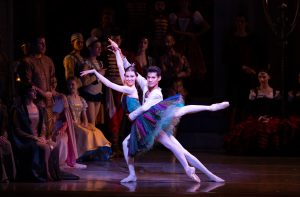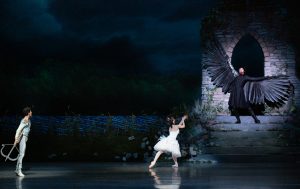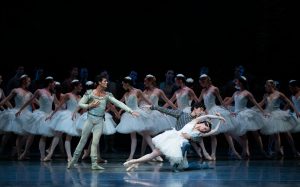
Today, it’s hard to imagine that Swan Lake, the most iconic evening-length ballet, was not a success when it was first created in 1877. It is now — without a doubt — the most respected of classical ballets and it is the pinnacle of achievement for a ballet company to have a successful version in the repertory.
Artistic Director Lourdes Lopez makes no bones sharing what an arduous task it was to get a full-length Swan Lake on the stage for Miami City Ballet. First, there was the decision of which production of the many different versions that exist would be the right fit not just for the MCB dancers but also for their audiences. Then, of course, there was the enormous challenge of fundraising for such an elaborate and expensive production. And if that wasn’t enough, COVID-19 came along and postponed the project even further.
But six years later, Lopez’s dream has finally come to fruition. Over the weekend of Feb. 19-20, Miami City Ballet presented a striking rendering of Swan Lake, created by Alexei Ratmansky, at the Kravis Center of the Performing Arts. Ratmansky, former artistic director of the Bolshoi Ballet and current artist-in-residence at American Ballet Theatre, is “the” choreographer of today’s ballet world and his version of Swan Lake is radically different from what one expects to see when going to the most classic of classical ballets. It’s a real feather shakeup.
In fact, if you had not read the copious notes in the digital program on your iPhone’s too-tiny screen before the performance, you might have thought that it was a contemporary reimagining of the popular ballet, but you would have been dead wrong. It is a historically accurate reconstruction of the 1895 Mariinsky production in St. Petersburg. Culled from rediscovered dance notation plans that had been smuggled out of Soviet Russia in 1919 and hidden away at Harvard University, Ratmansky and his wife Tatiana, working together, were determined to put the true soul of the original production back into their reconstruction.
The Stepanov notations (which preserved the original dance steps in a written system based on the
principles of musical notation) contained large blank passages. Ratmansky, with his innate skill in combining ballet steps and his vast accrued knowledge of historical ballet, had just the right skillset to fill in the gaps and create a choreographically seamless version of the original 1895 production.
The lead roles on Feb. 20 were danced by Viktorina Kapitonova, a guest artist from the Boston Ballet who originated the role in 2016 when she was dancing with the Zurich Ballet, and MCB Principal Renan Cerdeiro. Kapitonova was captivating in the role of Odette, Queen of the Swans. With a little gold crown perched on her head, she convincingly showed her strength and vulnerability (as well as her lovely lines and technique) as she encountered and, despite her hesitation, fell in love with her prince in the dark forest by the lake.

In Act II, Kapitonova presented so differently. In her first variation as Odile, there were a few brief moments of slight awkwardness which quickly evaporated once she was partnered by Cerdeiro, whom she charmed with her beguiling femininity rather than any evilness. The Ratmansky version does include those famous fouettés en tournant, which Kapitonova knocked off with such ease that I didn’t bother counting to see if she made it up to 32.
Cerdeiro’s role of Ratmansky’s Prince Siegfried seemed diminished compared to the “newer” interpretations we have seen of this role, where the dancer is encouraged to show off how much male ballet technique has evolved since 1895. Cerdeiro, dressed in bright white tights and tunic, was a gentler presence and therefore more of an accessory for his lead ballerina. He was a most attentive partner to Kapitonova, whom I overheard had just arrived a few days earlier to rehearse and replace sidelined MCB Principals Katia Carranza and Nathalia Arja. Cerdeiro, in all his solo variations, gave us an elegant and polished performance — as always.
The sets of the castle and the forested lake were impressive. Medieval in tone and receding into the background to give added depth, they were a perfect backdrop to the glorious costumes in which the inhabitants and visitors of the castle paraded across the stage. The luxurious fabrics were layered with rich textures and, as each different group danced, a change in the color palette was introduced. It was if you were looking at a magnificently large medieval painting where every detail was caught with a minute brushstroke. The sets and costumes were by Jérôme Kaplan, a French designer for opera, theater and ballet who has worked extensively with Ratmansky.
Over time, nearly every restaged version of Swan Lake has modified or changed the ballet’s scenario (storyline), whereas the traditional choreography of Marius Petipa and Lev Ivanov has been carefully preserved. The direction of the tour en l’aires, fouettés or menages might change to accommodate a dancer’s preferred side but there is a reverence for the original steps which — by all accounts — ballet professionals consider sacrosanct.
The many interpretations of the characters and their intentions have altered not only the storyline but the feel of the ballet as well as the look of it. We have come to have certain expectations of what to expect from this ballet of all ballets.
MCB’s Swan Lake is different. Gone are the tidy ballet buns — replaced by long ringlets that bounce down the expressive backs of the female dancers, reminding us that they are women, not swans, in the famous night forest scenes. Gone, too, are the stiff white tutus — replaced with soft, to-the-knee, layered and feathered skirts that dance themselves to the much quicker tempo of the music. Gone is the evil role of the Black Swan — replaced by Von Rothbart’s daughter, Odile, dressed in a multi-colored iridescent tutu — a party dress — rather the traditional stark, stiff black tutu.

In the Feb. 20 performance, the pantomime between the lead characters as well as the corps de ballet was exceptionally clear and well-integrated into the staging and nicely advanced the storyline. Often, in classical ballets, the mimed gestures can seem empty and even somewhat silly but, in this production, they were surprisingly convincing.
In Act I, Scene I, the Pastoral Waltz was an absolute visual delight with its cast of 40 dancers — the ladies with baskets of flowers held high and the men with small footstools which the dancers used to stand on and vary the height of different poses. Towards the end, a marvelous tall maypole was brought in that had three tiers of multi-colored ribbons that the dancers held as they circled and danced around the pole.
In Act I, Scene II, Von Rothbart, the evil genius brought to life by Cameron Catazaro, was all doom and fury. Dressed in black and silver with a cape of giant gray feathers that looked more like a marauding hawk than an owl, Catazaro commanded the stage with his strong presence and dramatic gestures. Also memorable and still holding a favorite place in Scene II was the the famous quartet of the Little Swans, danced with perfection — in a flutter of precise, staccato footwork under quiet arms clasped across each other — by Mayumi Enokibara, Nina Fernandes, Ellen Grocki and Ashley Knox.
In Act II, Hannah Fischer made a stately entrance as a kinder, more understanding Queen Mother. She looked absolutely stunning in a skintight, black velvet dress with a long train of black and gold lamé and a sensational neckpiece made of golden feathers. Von Rothbart wore a chain-link hood, a suit of armor and an endless cape — very medieval — as he sat next to the queen, red beard blazing.
But this was only the beginning of the costume parade. In the halls of the castle hung with Eastern tapestries, the fiancées were downplayed in simple uniform gowns of different colors while the Spanish dancers were bold in red and black as they showed their flair with the local dance. The Neapolitan dancers had easy smiles and carried their lyres and tambourines while performing and the Hungarian dancers were haughty in their rich rust-to-burgundy folk clothing as they clicked the heels of their brown boots. Wearing traditional costumes in pea-green velvet with matching little box hats sporting one upright feather, the Polish dancers closed the rich fare that entertained the royals in their celebration.

In Act III, as the white swans’ bevy of feathered soft tutus filled the stage once again, a scattering of black swans appeared, intermingling or collecting in a dark line, adding to the drama of Siegfried coming to find Odette after having betrayed her. The end is the original version. First, Odette killed herself and then, Siegfried killed himself. The curtain comes down on the somewhat cheesy ending of Odette and Siegfried, reunited in death, sitting in a large swan carriage and floating towards their eternal life together.
Some audience members may have found these departures from what they have grown accustomed to in a Swan Lake production unsettling. Frankly, I found the revisions from the 1895 production gave an element of freshness to MCB’s Swan Lake. Bathed in the atmospheric lighting design by Mark Stanley, the corps de ballet was a strong, cohesive and integral part of the production. Whether it was in the lake scenes, where the swans were shown more as human beings rather than ethereal beings as they framed and echoed the drama of the main characters, or whether it was in the castle scenes, where the townspeople mingled, watched and danced, the dancers of the corps de ballet were fully present adding an overall vitality to the ballet.
Combined with the strong performances of the main characters, the result was — as Ratmansky had hoped — a Swan Lake with more soul. It is an important addition to Miami City Ballet’s repertory and I believe, like a good wine, it will age well. I look forward to viewing it again.
The Opus One Orchestra, which was led with command by guest conductor Beatrice Jona Affron, was in admirable form, excelling in the quicker-than-usual tempo of Tchaikovsky’s music. Swan Lake was the Russian composer’s first ballet score and at the premiere, it too was regarded as a failure by the critics — too “Wagnerian,” they complained. Before Act III began, the orchestra and their maestro received a rousing and appreciative round of applause from the audience, which the musicians acknowledged with a charming gesture of wind instruments and waving bows appearing just above the orchestra pit, as if to say: “It is so good to be back performing.